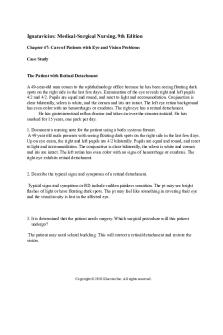Unit 13- Lesson 47- Mutual Grim Trigger as Nash Equilibrium PDF

| Title | Unit 13- Lesson 47- Mutual Grim Trigger as Nash Equilibrium |
|---|---|
| Course | Politics and Strategy |
| Institution | University of California Los Angeles |
| Pages | 1 |
| File Size | 38 KB |
| File Type | |
| Total Downloads | 10 |
| Total Views | 140 |
Summary
Spring 2016
Prof. Kathleen Brown...
Description
Lesson 47: Mutual Grim Trigger as Nash Equilibrium Need to show not just that GT is better than Unconditional Defect, but better than any other strategy. Cannot consider each possible alternative strategy individually - - they are infinite. Need to be to think about other able to group them. What about other ways of deviating from GT? Other Way #1. Cooperate after someone has defected. Given that other player is playing GT, this will result in sucker pay-off. For example: Alt 1: Defect, then cooperate, then return to GT 1
2
3
4
5
A’s Action
D
C
D
D
D
B’s Action
C
D
D
D
D
A’s Pay-Off
5
-2
0
0
0
Value (Dev2) = 5-2∂ Value (GT) = 3 + 3∂ + 3∂^2 + ... This way of deviating gives a lower pay-off than UD. V(A)(Dev 2) ≤ V(A)(Dev 1) because 5 - 2∂ < 5 whenever ∂ > 0. So whenever UD is not better than Grim Trigger (Whenever 5 ≤ [3 / (1-∂)], Alt 1 will also not be better (5 2∂ will also be less than [3 / (1-∂)]) Alt 2: Defect after cooperating for awhile? 1
2
3
4
5
A’s Action
C
C
D
D
D
B’s Action
C
C
C
D
D
A’s Pay-Off
3
3
5
0
0
Value (Dev2) = 3 + 3∂ + 5∂^2 Value (GT) = 3 + 3∂ + 3∂^2 + ... Alt 2 is not an improvement if 3 + 3∂ + 5∂^2 ≤ 3 + 3∂ + 3∂^2 + 3∂^3 + ... The first two terms on each side cancel and we can factor out ∂^2 to get 5 ≤ 3 + 3∂ + 3∂^2 + 3∂^3 + ... which is a condition as UD Idea: If it’s worthwhile to defect at any point, it’s worth defecting right away Never need to compare one deviation to another Summary: Showing that strategies from an equilibrium is a...
Similar Free PDFs

Lesson 13 Long Run Equilibrium
- 13 Pages

41629712 Equilibrio de Nash
- 11 Pages

Lesson 8 - Chapter 13 - Question
- 1 Pages

Econ0002 - Unit 13 Notes
- 12 Pages

Odysseus Week 13 - Lesson 1
- 3 Pages

Rmbi1010 tut06 nash
- 4 Pages

Lesson 13 - Lecture notes 1
- 7 Pages

Lesson-13-Outline Spring 2020
- 4 Pages

Pcubsa Assignment 1 Lesson 13
- 10 Pages

Unit-13 - Text Book - Chapter 13
- 7 Pages

Practice-Unit 3 - lesson 2
- 1 Pages
Popular Institutions
- Tinajero National High School - Annex
- Politeknik Caltex Riau
- Yokohama City University
- SGT University
- University of Al-Qadisiyah
- Divine Word College of Vigan
- Techniek College Rotterdam
- Universidade de Santiago
- Universiti Teknologi MARA Cawangan Johor Kampus Pasir Gudang
- Poltekkes Kemenkes Yogyakarta
- Baguio City National High School
- Colegio san marcos
- preparatoria uno
- Centro de Bachillerato Tecnológico Industrial y de Servicios No. 107
- Dalian Maritime University
- Quang Trung Secondary School
- Colegio Tecnológico en Informática
- Corporación Regional de Educación Superior
- Grupo CEDVA
- Dar Al Uloom University
- Centro de Estudios Preuniversitarios de la Universidad Nacional de Ingeniería
- 上智大学
- Aakash International School, Nuna Majara
- San Felipe Neri Catholic School
- Kang Chiao International School - New Taipei City
- Misamis Occidental National High School
- Institución Educativa Escuela Normal Juan Ladrilleros
- Kolehiyo ng Pantukan
- Batanes State College
- Instituto Continental
- Sekolah Menengah Kejuruan Kesehatan Kaltara (Tarakan)
- Colegio de La Inmaculada Concepcion - Cebu




